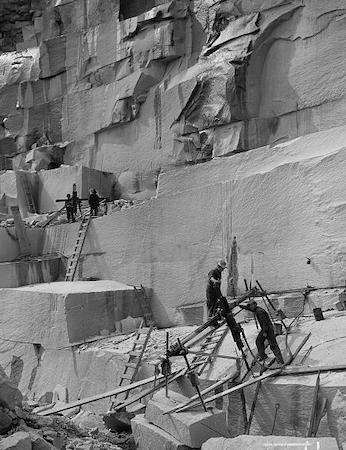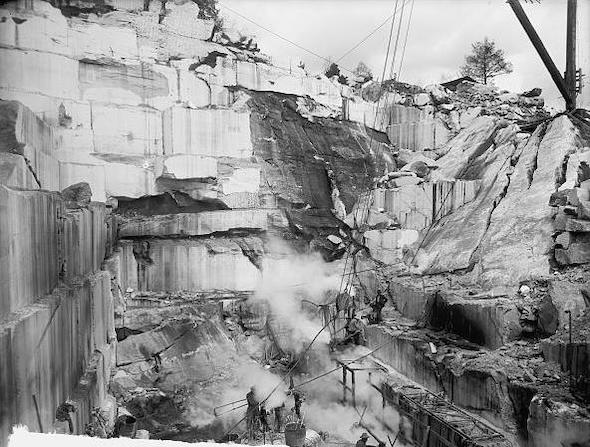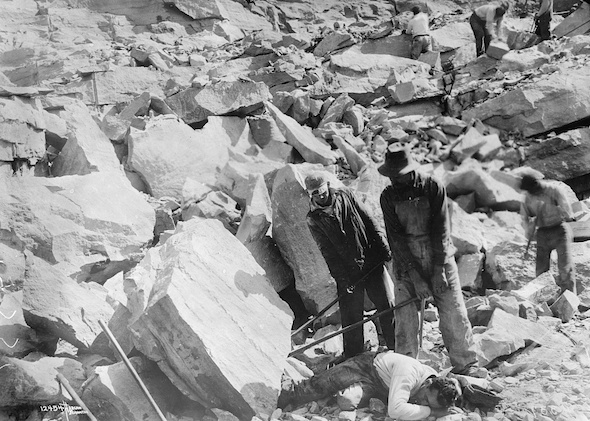Overall Context
Historians have produced several studies on changes in workplace safety culture from the beginning of the 20th Century and the legislative, legal, and social pressures that shifted the view of workplace accidents from something that was an inevitable byproduct of dangerous work to a failure of management initiatives. As the country industrialized throughout in the mid-to-late 1800s, new machinery and processes were introduced that made workplaces increasingly dangerous. Government commissions began to examine safety within certain industries, and attention was brought to the legal framework of accident compensation. In the 1910s states began to enact workers’ compensation laws, which required employers to compensate workers or their families for injury or death on the job regardless of fault. By 1920 forty-four states had some form of worker’s compensation legislation in place.[1] This legislation led to the increasing presence of safety programs within the workplace to reduce accidents as part of management procedure. Some industries, particularly manufacturing, were quicker to implement safety programs than others.[2] Environmental regulations were slower to develop than safety legislation, with the first federal protective legislation not enacted until the 1940s. However, the first conservation groups were established in the late 1800s, and an early battle in the environmental movement involved stopping stone quarrying activities along the Palisades in New Jersey and the creation of the Palisades Interstate Park in 1909.[3]

Quarry Operations in Concord, New Hampshire c. 1908 [4]
Most previous studies around changing workplace safety standards with an industrial rather than regulatory focus have investigated the mining and railroad industries, which were exceptionally dangerous workplaces in the 1800s. Other historians have studied the history of factory safety programs after the 1910s where there was an immediate measurable change to procedures.[5] Several environmental histories have been written that focus on the mining industry. The work of stone quarrying incorporates many of the same dangers that have been studied by historians of mining, but also includes a factory component, as the stone finishing process requires blocks of stone to be shaped by increasingly complex machinery in finishing shops. As these shops were largely owned by the same companies doing the quarrying they are an integral part of the stone industry. Quarrying has never been as important an industry as mining to the government, so there is less direct regulatory history than there is for mining. The stone industry overall is little studied outside small regional histories of places where stone is located. However, it is an industry with an enormous impact on the built environment we live in, and its double role in both resource extraction and factory work makes it particularly interesting in terms of how its safety processes were developed and spoken about. In my own investigations I have found almost no previous work on the history of quarry safety standards and very little work related to the quarry industry within the context of environmental studies.
The Stone Quarrying Industry in the United States, 1888-1920
Quarrying prior to the 1800s was primarily a local affair, where stone was removed from surface layers for a specific (and nearby) structure. Commercial quarries developed as demand increased for stone for use in gravestones, structures, and the production of lime. [6] Development of a quarry was an expensive undertaking, as surface layers of stone were generally of poor quality and needed to be removed to reach commercially-viable stone.[7] The construction of canals and railways in the mid-1800s allowed stone to be transported for greater distances from the quarries. Better transportation, larger markets, and introduction of steam-powered (and later electric) quarrying machinery led to an increase in the number of quarries across the country. By 1917 there were over 3,000 active quarries in the United States.[8] In addition to the work of quarrying, the stone industry employed workers in finishing shops and sheds. Stone products included dimension stone (used in buildings, paving, curbs, and monuments); crushed and broken stone (used in ballast, riprap, road work, and concrete production); and stone used for manufacturing purposes such as the production of lime, fertilizer, sugar, and glass.[9] Stone: An Illustrated Magazine billed itself as “A Journal For Producers, Workers and Users of Stone, Marble and Granite,” but covered all aspects of the stone industry, including crushed stone and manufacturing products.
While some quarrying took place underground, most quarries were either “shelf” quarries, where the stone was removed from a side of a hill, or “pit” quarries, where the stone was removed from below grade.[10] Dimension stone was quarried through the use of specialized cutting machines and wedges with methods specific to the stone being quarried, and then shaped to its final form within stone sheds and finishing shops with additional machinery. Pneumatic (air-driven) tools came into general use in these shops by the late 1890s. Sandblasting and jackhammers were added in the 1920s.[11] Explosives were not frequently used in the production of dimension stone, as they could damage the final product, but were often used to produce stone fragments for riprap or rubble, crushed stone, and manufacturing stone products.[12]

Quarry Operations in Knoxville, Tennessee c. 1903 [13]
Dangers in Stone Quarrying
Dangers in the work of stone quarrying were described within the pages of Stone itself. “Stone-Quarry Investigations” from the July 1917 issue summarized some frequent causes of accidents within the industry, including “boiler explosions, falls of derricks, and accidents due to insufficiently protected rotating machinery, electric wires, and quarry stairs and ladders … improper handling, loading, and firing of explosives, and dangerous methods of handling rock or overburden.”[14] In addition to falls, explosions, and rock slides, the stone industry faced a serious health hazard. Silicosis is an occupational lung disease caused by exposure to fine particles of crystalline silica dust, present in almost all sands and rocks. While quarrying and mining have been recognized throughout history as occupations with a high risk of respiratory disease, it took a long time to identify the exact cause due to its complicated relationship with tuberculosis. Lung damage from silica predisposes victims to later contract bacterial tuberculosis.[15] Silicosis did not affect all portions of the stone industry equally, as it is dependent on the composition of the stone being ground into dust. It was particularly severe in the granite industry.[16] The word “silicosis” itself did not come into general use until the late 1910s, and is not present in the digitized pages of Stone, which instead refers to conditions such as “stone consumption,” “miner’s consumption” and “phthisis.”
While not typically as destructive as most mineral mining operations, quarrying does dramatically alter the landscape, leaving behind permanent scars.[17] Quarry operations also produced air-borne dust and smoke that affected wide areas and nearby populations.[18] Articles in Stone described conflicts between quarries and their surrounding neighborhoods around health and environmental issues.

"First Aid in the Quarry," American Red Cross Photo c. 1920 [19]
Topics and Themes of Analysis
I used basic text analysis techniques to study language around hazards, safety, health, and environmental issues in Stone. I hoped that by using a variety of techniques that I might be able to determine general trends to guide my research in these areas. My final investigations for this project use the following methods of text analysis:
- Word frequency over time: To look at words associated with safety, health, and environmental issues and how their use changes.
Results for this method can be found here
- Keyword in context: To determine where words associated with safety, health, and environmental issues appear within the journal and what they are being used to discuss.
Results for this method can be found here
- Word vector analysis: To examine groups of words to determine what additional words are used in semantically similar contexts to obtain a broader picture of how issues are perceived.
Results for this method can be found here
Details on how I have implemented these methods can be found in the Analysis Methods section of this site.
Footnotes
[1] Price Fishback and Shawn Kantor, A Prelude to the Welfare State the Origins of Workers’ Compensation (Chicago: University of Chicago Press, 2000), 102-104.
[2] Mark Aldrich, Safety First: Technology, Labor, and Business in the Building of American Work Safety, 1870-1939 (Baltimore, MD: Johns Hopkins University Press, 1997), 6.
[3] Frances F. Dunwell, The Hudson: America’s River (New York: Columbia University Press, 2008), 272.
[4] Detroit Publishing Co., “Channeling in a New England granite quarry, United States, New Hampshire, Concord” ca. 1908. Photograph. https://www.loc.gov/item/2016813994/.
[5] A compilation of works studying safety in these industries can be found in the “Notes on Sources” section in Aldrich’s Safety First.
[6] Harley J. McKee, Introduction to Early American Masonry: Stone, Brick, Mortar and Plaster (New York: The Association for Preservation Technology International, 2017), 13.
[7] Harley J. McKee “Early Ways of Quarrying and Working Stone in the United States.” Bulletin of the Association for Preservation Technology 3, No. 1, (1971), 54.
[8] “Stone Quarry Investigations” Stone 38 No. 7 (July 1917), 363.
[9] Oliver Bowles, The Stone Industries: Dimension Stone, Crushed Stone, Geology, Technology, Distribution, Utilization (New York: McGraw-Hill Book Company, Inc., 1939), 391-392.
[10] Ibid, 18.
[11] David R. Seager, “Barre, Vermont Granite Workers and the Struggle Against Silicosis, 1890-1960.” Labor History 42, No. 1 (2001), 65.
[12] “Quarry Methods,” Stone 1, No. 5 (September 1888), 114.
[13] Detroit Publishing Co., Republic Marble Quarry near Knoxville, Tenn., ca. 1903. Photograph. https://www.loc.gov/item/2016803208/.
[14]”Stone-Quarry Investigations,” Stone 38, No. 7 (July 1917), 363.
[15] Gillian Burke and Peter Richardson, “The Profits of Death: A Comparative Study of Miners’ Phthisis in Cornwall and the Transvaal, 1876-1918,” Journal of Southern African Studies 4, No. 2 (1978), 151.
[16] Paul-André Rosental, Silicosis: A World History (Baltimore, Maryland: Johns Hopkins University Press, 2017), 48.
[17] Sebastian Haumann, “Ubiquitous Mining: The Spatial Patterns of Limestone Quarrying in Late Nineteenth Century Rhineland.” RCC Perspectives, No. 10, Mining in Central Europe: Perspectives from Environmental History (2012), 59.
[18] Michael Austin, “Carving Out a Sense of Place: The Making of the Marble Valley and the Marble City of Vermont,” (PhD diss., University of New Hampshire, 2002), 106.
[19] “First Aid in the Quarry,” American National Red Cross photograph collection, 1920. Photograph. https://www.loc.gov/item/2017673320/.